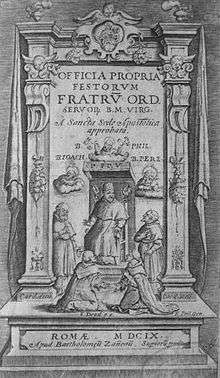Filippo Ferrari
Filippo Ferrari (Philippus Ferrarius) (1551 – 1626) was an Italian Servite monk and scholar, known as a geographer, and also noted as a hagiographer.[2]

Life
He was born at Oviglio in Piedmont. It is near Alessandria, and he was nicknamed Alessandrino (Philippus Ferrarius Alexandrinus). He taught mathematics for 48 years at the University of Pavia.[3]
Ferrari was prior general of his order from 1604 to 1609, and vicar general in 1624/5.[4] He was therefore head of the Servites at the time of the Venetian Interdict, and was consulted by Paolo Sarpi in Venice.[5][6] A detailed account of Ferrari's dealings with Pope Paul V during the confrontation of those years was given by Fulgenzio Micanzio, Sarpi's ally.[7] It was with Ferrari's approval that Sarpi took up the appointment as theological consultant to Venice on 28 January 1606.[8]
Works
Ferrari published his Epitome Geographicum in 1605.[9] His Lexicon Geographicum was published internationally in a number of later editions: edited by William Dillingham (London, 1657),[10] and by Michel Antoine Baudrand (Paris, 1670).[11] It was used in the Dictionarium Historicum, (Oxford, 1670) of Nicholas Lloyd.[12]
Other works included:
Notes
- "servidimaria.org, Ferrari Filippo". Archived from the original on 9 September 2012. Retrieved 11 April 2012.
- John Aikin; William Johnston (1803). General Biography: Or Lives, Critical And Historical, Of The Most Eminent Persons of All Ages, Countries, Conditions And Professions, Arranged According To Alphabetical Order. Robinson. p. 74.
- "Archived copy". Archived from the original on 5 July 2010. Retrieved 11 April 2012.CS1 maint: archived copy as title (link)
- https://archive.org/stream/paulpopepaulfria00trol#page/208/mode/2up
- Aurelio Bianchi-Giovini (1836). Biografia di frà Paolo Sarpi, teologo e consultore di Stato della repubblica Veneta (in Italian). p. 239.
- Fulgenzio Micanzio (1651). The life of the most learned Father Paul: of the order of the Servie. Covncellour of state to the most serene republicke of Venice, and authour of The history of the Covnsell of Trent. Printed for Humphrey Moseley and Richard Marriot. p. 107.
- (in Italian) treccani.it, Micanzio, Fulgenzio.
- Filippo Ferrari (1605). Epitome geographicum: in quattour libros divisum. Viani. Retrieved 11 April 2012.
- . Dictionary of National Biography. London: Smith, Elder & Co. 1885–1900.
- Filippo Ferrari (1670). Lexicon geographicum... Illud primum in lucem edidit Philippus Ferrarius,... nunc Michael Antonius Baudrand,... hanc editionem... dimidia parte auctiorem fecit. Apud F. Muguet. Retrieved 11 April 2012.
- Dictionary of National Biography, Lloyd, Nicholas (1630–1680), historical compiler, by Thompson Cooper. Published 1892.
- Filippo Ferrari (1609). Nova Topographia in Martyrologium Romanum. Apud Bernardum Iuntam, Io. Baptistam Ciottum, & Socios. Retrieved 11 April 2012.
- Filippo Ferrari (1613). Catalogus sanctorum Italiae in menses duodecim distributus. Bordonius. Retrieved 11 April 2012.
- Filippo Ferrari (1625). Catalogus generalis sanctorum, qui in Martyrologio Rom. non-sunt, ex variis martyrologiis, kalendariis, tabulis, monumentisque ecclesiarum, necnon vitis eorundem impressis; ... collectus, ac in duodecim menses instar martyrologij distributus suis vbique n. apud J. Guerilium. Retrieved 11 April 2012.
External links
- CERL page.
- (in Italian) Italian dictionary entry.
- (in Italian) Comune de Oviglio.